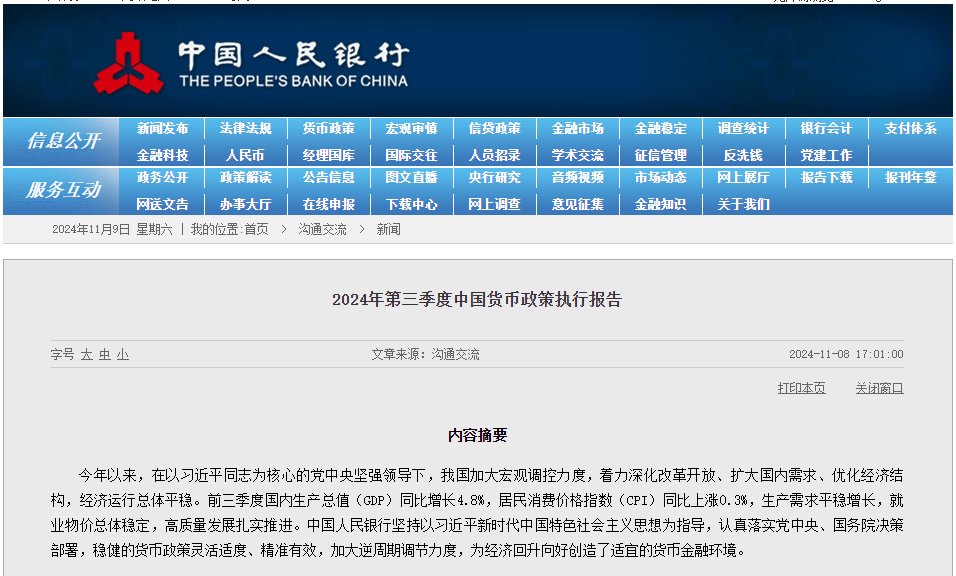
Recently, the People's Bank of China released the "Monetary Policy Implementation Report for the Third Quarter of 2024" (referred to as the "Report" on its official website. This report comprehensively reviews China's current economic situation and monetary policy operations, and provides clear guidance for the future policy direction.
In the face of a complex and volatile domestic and international economic environment, how can the central bank support the steady progress of the economy? What information is worth paying attention to in the report? Jingtai interprets it for you.

Interpretation 1| Domestic economy: The margin is more optimistic, focusing on prices and expectations
The report believes that in the first three quarters of 2024, China's economic operation is described as "generally stable, stable and progressive", compared with the "overall stability" in the first half of the year, this statement shows a certain degree of optimism.
On the price front, the People's Bank of China has always regarded price stabilization as one of its key policy objectives. In the third quarter, the consumer price index (CPI) rose by 0.5%, 0.6% and 0.4% year-on-year, respectively, and increased by an average of 0.3% in the first three quarters, indicating a moderate rise in inflation. In addition, a series of new policies to promote economic growth recently introduced by the government will also help stimulate consumer demand and macroeconomic growth. A modest rebound in inflation could help ease the pressure on some sectors from high real interest rates, which, combined with rate cuts, could create better financial conditions for economic growth.
In terms of policy support, the "double and two new" policy was implemented in the second quarter, while a series of new measures to stabilize growth were introduced in the third quarter, and the effects of these policies are gradually emerging. Market expectations have also improved, which has further enhanced the effect of the policy.
In the future, policy support will not weaken. Recently, the Standing Committee of the National People's Congress announced a debt resolution plan of more than 10 trillion yuan, exceeding market expectations. It is expected that more supportive policies will be introduced around the economic work conference in December, such as real estate tax incentives and debt swaps. During next year's National People's Congress and the National People's Congress, measures such as raising the fiscal deficit ratio and issuing special treasury bonds may be further deployed to continue to promote economic development. These orderly policies show that the government has played an active role in the adjustment of the economic cycle and provided a sustained impetus to the economy.
Interpretation 2: Overseas economy: pay attention to inflation and changes in the monetary policy of major overseas central banks
The report notes that in order to meet future economic challenges, the next phase needs to ensure a reasonable increase in financing and monetary aggregates. At the same time, it is necessary to pay close attention to the changes in the monetary policies of major overseas countries, and continue to monitor the liquidity of the banking system and the dynamics of the financial market.
At present, the US service sector inflation is relatively stubborn, and geopolitical events have led to volatility in commodity prices, which makes the downward trend of US inflation uncertain. The tight labor market in the United States, with wages growing faster than consumer price increases, makes it difficult for services inflation to come down quickly, creating internal barriers to further price declines. At the same time, geopolitical instability has also increased uncertainty about the trajectory of inflation in the United States.
In addition, the domestic and foreign policies of developed countries such as the United States may also change. Mr. Trump, for example, is a supporter of trade protectionism and, if re-elected, has promised to impose a 10 percent tariff on all goods imported into the United States, with tariffs on Chinese goods in particular possibly as high as 60 percent. If these tariff policies are implemented, it may cause some disruption to our exports.
The combination of these two factors will have an impact on the global economic outlook, and for our country, the uncertainty of external demand may increase. In the first half of this year, due to the unexpected resilience of the U.S. economy and the impact of the inventory replenishment cycle, overseas demand rebounded significantly, which promoted the growth of China's exports, with an export growth rate of 6.2% in the first three quarters, and exports to major markets such as Europe, the United States and Japan increased by 4.2%. However, with the continued low growth of the global economy, especially given the possible trade restrictions imposed by the United States, it is expected that China's exports will face greater uncertainty next year.
Interpretation 3: In terms of monetary policy: to improve the accuracy of monetary policy, M1 and M2 will be more sensitive
A new column has been added to the report, which discusses the important changes in the scope of financial instruments under the definition of money supply, and suggests that the statistical caliber of money supply should be dynamically adjusted according to the actual situation.
Specifically, there are two main points:
First, consider adding two new, more flexible forms of money to M1 (narrow money supply). With the advancement of bank cards and mobile payment technology, personal demand deposits have become a very convenient payment method, so many people think that it should be counted in M1.
The other is the reserve of non-bank payment institutions, in recent years, with the rapid development of online payment, the scale of this type of reserve has been expanding, and it plays an increasingly important role in people's daily payment, in fact, they have similar monetary characteristics to demand deposits. As a result, personal demand deposits and reserves for non-bank payment institutions may be added to the M1 statistics, as they can be directly converted into spending power.
For M2 (broad money supply), although the central bank did not give a specific adjustment plan, it emphasized that the statistics of M2 need to be adjusted in a timely manner with the change in the liquidity of financial instruments. This means that the statistical caliber of M2 may also change in the future.
Referring to the experience of other countries, as the economy develops, the effectiveness of the traditional money supply control method will gradually decrease, and its relationship with major economic indicators such as economic growth will also weaken. Therefore, the economic management strategy will shift from relying on quantitative regulation to paying more attention to price-based regulation. It is expected that after the adjustment of the statistical caliber of the money supply, M1 and M2 will be able to more accurately reflect the changes in economic activity and become more valuable indicators for predicting economic trends.
Interpretation 4: Market-oriented interest rates: Promote market-oriented interest rate reform and improve the transmission efficiency of policy interest rates
The report pointed out that the transmission efficiency of interest rates in the deposit and loan market is not high, which affects the regulatory effect of monetary policy and also limits the operating space of monetary policy. To this end, in the next stage, the People's Bank of China will continue to deepen the market-oriented reform of interest rates, maintain the order of fair competition in the market, and improve the transmission efficiency of policy interest rates. Previously, the central bank had pointed out the shortcomings of China's market interest rate transmission mechanism in the second quarter report. Specifically, it is difficult to lower bank deposit interest rates due to the strong influence of the "scale complex", and at the same time, under the fierce market competition, bank loan interest rates have fallen too fast, resulting in a widening gap between deposit and loan interest rates and policy interest rates. These problems not only affect the implementation effect of monetary policy, but also limit the operating space of monetary policy.
In order to deal with these problems, the central bank plans to improve the efficiency of interest rate transmission in the following ways: strengthen industry self-discipline and maintain a level playing field; Optimize the fund transfer pricing (FTP) mechanism within the bank, etc.
At present, the operation of the economy needs more countercyclical adjustment measures, but due to the constraints of factors such as net interest margin and exchange rate, the room for further interest rate cuts is limited. Therefore, in the future, the central bank will rationalize the interest rate transmission mechanism of the deposit and loan market by standardizing the pricing behavior of bank deposits and loans, such as standardizing the market pricing of deposit interest rates and cleaning up improper manual interest supplements, so as to provide more space for the operation of monetary policy.





